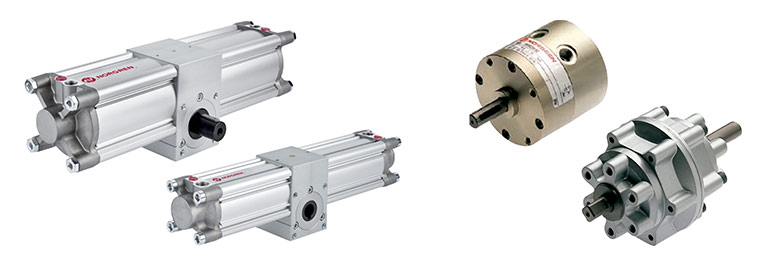By Josh Cosford, Contributing Editor
Rotary actuators are devices used to transmit torque through a limited rotational arc. Rather than pneumatic motors, which rotate continuously, pneumatic rotary actuators move a load through a limited range of motion. Some actuators rotate through two discrete positions, while others are capable of positioning at any angle around the arc.
The two most common rotary actuator construction types in pneumatic fluid power systems are the vane and rack and pinion. In addition, a diaphragm-style rotary actuator is popular in the process equipment industry, and the Scotch Yoke style of actuator provides high torque for valve actuators in oil & gas. Still, both applications are less common in fluid power.
The vane rotary actuator looks much like an air motor, with a shaft protruding from its mounting face. Two air ports connect internally to the common chamber separated by the vane. Pressure at one port forces the vane towards the opposing port with force equal to the vane’s surface area multiplied by the pressure differential at that chamber. The vane-type rotary actuator makes an excellent two-point operation for industrial automation requiring a load to move quickly between two positions. Although most models offer stroke adjustment, the function pertains mainly to fine-tuning the end-of-stroke position.
Rack and pinion rotary actuators are like two air cylinders working in opposite directions and joined at the center by the rack and pinion. As each cylinder strokes, the horizontal motion of their racks forces the center pinion to rotate. The torque created is a combination of the cylinders’ forces and the diameter of the pinion gear. Rack and pinion style actuators offer superior side load resistance. The reinforcement from its bearing and abutment of the racks help ensure the load is well-supported.

The rack and pinion rotary actuator works well cycling to the end of the stroke and at any point in between. It is not capable of supporting a load mid-stroke in the same fashion a hydraulic application could. However, with position feedback (like an encoder) and sophisticated control valves, rapid and accurate positioning is possible.
Vane-type rotary actuators rarely achieve more than 270 degrees of rotation because their action is like a swinging door. However, rack and pinion actuators are limited only by the stroke of the air cylinders powering them. So it’s not unreasonable to expect a thousand degrees or more of rotation.
Accessories improve the function of any rotary actuator. Position switches located on the body of an actuator may provide a signal for end-of-stroke confirmation for either vane or rack and pinion styles. Many position sensors, such as magnet-sensing reed switches along the length of the rack-and-pinion cylinders, may allow discrete positioning anywhere along stroke length. Furthermore, if infinite positioning suits the process, LDTs may be installed to provide an accurate position signal to be relayed to the PLC.
Popular applications for the rotary actuator are rotary tables, which are used in automation to position workpieces at various work stages as part of a process. In addition, pick and place applications with partial rotation are suitable for vane-type actuators. Other typical applications are tilting, braking, tensioning and lifting.
Filed Under: Components Oil Coolers, Cylinders & Actuators, Engineering Basics, Pneumatic Tips